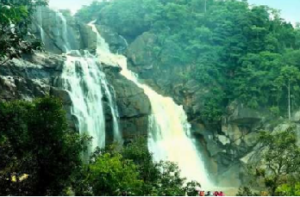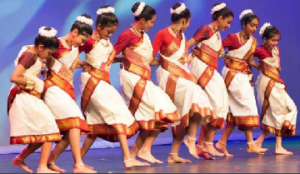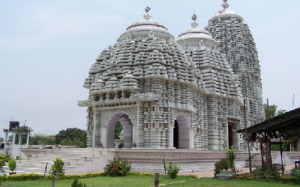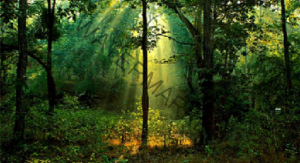Jharkhand
Architecture & History
- In the ancient times of Mahajanpadas around 500 BCE, Jharkhand state was a part of Mgadha and Anga.
- In the Mauryan period, this region was ruled by a number of states, which were collectively known as the Atavika (forest) states. Samrat Samudra Gupta ruled over the present-day Chotanagpur region.
- Chinese traveller Xuanzang described the kingdom around the present Jharkhand situated to the north was Magadha, Champa in the east, Mahendra in the west and Orissa in the south.
- The houses have thatched roof covered with wild grass, walls being made of mud brick. In the present days wild grass have been replaced by paddy straw or country tiles. Walls are made of stones that come out as mining waste.
- Each house has following spaces within:
- The House with bedroom
- The Kitchen and adjacent garden
- A Burial Ground to keep useful bio waste
- A cattle space with poddar pot
- A Compost pit
- The house have the bath and toilet room outside the village separated from the houses.
- The house is protected by boundary made of mud, stone or wild bushes to prevent stray animals and cattle entering the house.
- The main entrance of the house is a semi open space build up that generally connects main courtyard & the main street.
Demographic Location
- "Jharkhand" means 'land of bush or forest'. The word "Jhar" means 'Forest' and "Khand" means 'land' in local Indian language.
- Geography. Jharkhand is located in the eastern part of India and is enclosed by Bihar to the northern side, Chhattisgarh and Uttar Pradesh to the western side, Odisha to the southern part and West Bengal to the eastern part
- The plateau of Chota Nagpur which is part of the vast Deccan plateau that occupies most of peninsular India is situated in the southern part of state of Jharkhand.
- Much of Jharkhand lies on the Chota Nagpur Plateau. Two third of the state is covered by forest.
- There are several rivers that pass through the Chota Nagpur plateau. They are:
- Damodar
- North Koel
- Barakar
- South Koel
- Sankh
- Subarnarekha rivers
- The higher watersheds of these rivers stretch out within the Jharkhand state.
- Some of the popular hilltops in Jharkhand :
- Ranchi Hill in Ranchi
- Satpahar in Hazaribagh
- Nandan Pahar in Deoghar
- Jharkhand has different type of soil.
- Sandy soil is generally found in Hazaribagh and Dhanbad.
- Black soil, is found in Rajmahal area.
- Laterite soil is found in western part of Ranchi, Palamu, and parts of Santhal Parganas and Singhbhum.
- Land of Jharkhand state is blessed with rich mineral reserves such as:
- Coal
- Iron ore
- Copper ore
- Uranium
- Mica
- Bauxite
- Granite
- Limestone
- Silver
- Graphite
- Magnetite and Dolomite
People, Rituals and Language
- Hindi is the official language in Jharkhand spoken by the people of state of Jharkhand. Other languages spoken include Nagpuri, Khortha, Kurmali, Magahi and Bhojpuri.
- Ho is tribal language spoken by the Ho, Munda, Kolha and Kol tribal communities of Odisha, Jharkhand, Bihar, Chhattisgarh, West Bengal, Assam and is written with the Warang Citi script.
- Four Indo-Aryan languages are spoken in the state of Jharkhand namely, Sadri/Nagpuri, Khortha, Kurmali and Panchparganiya,
- These languages are considered by most linguists to be dialects of other, larger languages of the region, such as Bhojpuri, Magahi and Maithili.
Season and Climate
- Climate of Jharkhand ranges from humid subtropical in the north to tropical wet and dry in the south-east.
- There are 5 main seasons in the state. They are summer, rainy, autumn, winter and spring.
- The best season to visit Ranchi is the winter season. In this season, the temperature remains moderate.
Culture & Education
- The staple foods of Jharkhand are vegetable, rice, dal, and pickle and they are stored in small rooms in every house.
- The vegetables are prepared in numerous ways like fried, roasted, boiled, or curried.
- Mahadeo is the God worshipped in Jharkhand.
- The people drink rice beer called DIYANG, that is a alcoholic drinks made up of fermented rice.
- Family system is nuclear type. Marriages commonly arranged by negotiation & bride price is paid.
- Tribal women enjoy better status within their own communities.
- The sacred grove near the village called DESSAULI.
- The meeting & dancing ground called AKHARA.
- Jhumair is one of the most popular folk dance of Jharkhand. It is usually performed by Kudmi during harvest season and festivals.
- Musical Instruments used are Mandar, Dhol, Nagara, Dhak, Bansi Shehnai.
- Some of the more performed Jharkhand dances are :
- Paika dance forms
- Chhau is one of the finest folk dances of Chhota Nagpur Plateau region
- Santhal is a popular folk dance
- Karma is another popular folk dance of the land
Famous Spots
- The popular places to visit in Jharkhand:
- Jagannath Temple at Ranchi built by king Ani Nath Shahdeo
- Maluti Temples in Dumka
- Palamu Forts
- Navratangarh Fort
- Khakparta Temple
- Shiva temple in Lohardaga
Aqualife, Flora & Fauna
- The territory of Jharkhand provides variety of flora and fauna that grows here.
- The main crops grown in Jharkhand region is rice, wheat, maize, Pulses (like Arhar, Urad, Moong, Gram).
- There are several national parks and the wildlife sanctuaries in Jharkhand that bring out a rich variety of life forms.
- Several species of animals are found in the national parks and wildlife sanctuaries of the territory. Some of the wildlife sanctuary of Jharkhand are:
- Hazaribagh Wildlife Sanctuary
- Betla National Park
- The animals commonly found in Jharkhand are Elephants, Bison, Wolf, Antelope, Rabbit, Fox, Sambhar, Wild boar, Python, Squirrel, Blue bull, Mongoose, Jackal, Honey badger, Malabar giant, Tiger, Deer, Langur, Rhesus, Python, Porcupine,,Wild cat
- Jharkhand has mainly dry and moist deciduous forests. Jharkhand possesses a semi-arid landscape, with an acute shortage of water during the hot summer months.
- Dry deciduous trees like sal, jackfruit, jamun, kendu, gambhar, shisham, mahua, katha, lac, pesar, mango, aasan, baheda and bamboo grow in abundance in Jharkhand.








